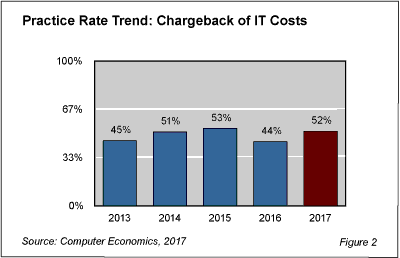Business leaders often perceive the IT organization as a cost sink. However, most IT activity is undertaken to support a business process, and when those support costs are shown to business leaders the perception of IT can change. Furthermore, when the real costs of support are made transparent, it is easier to prioritize, improve, or even eliminate them.
One way to eliminate this perception is to show or even charge back what departments are paying for services so they can better understand the factors that are driving their IT costs, prioritize their demands on IT, and understand the vital role IT is playing in their success. These benefits might be why the number of companies charging back or showing back IT costs has risen this year.
As shown in Figure 2 from the full report, Chargeback and Showback Adoption and Best Practices, 52% of organizations currently charge back IT spending, compared to 44% in 2016. Also, (not shown in this figure), the percentage of companies practicing showback has risen modestly from 34% in 2016 to 36% in 2017.

“Putting a price tag on something can have a profound effect,” said David Wagner, vice president of research for Computer Economics, based in Irvine, Calif. “Sometimes an application or capability seems vital until you have to pay for it out of your own budget. Then suddenly you see what you pay and it isn’t so vital anymore. This kind of transparency can lead to the business and the IT organization partnering to find better or cheaper solutions.”
The chargeback of IT costs is the billing back of some or all of IT expenses to the user departments that incur the costs. The practice of chargeback dates to the days of “big iron,” when computing resources were centralized and costs were relatively easy to assign. In the era of distributed computing, the task of charging back IT expenses became more complicated and often politically charged. Nevertheless, large companies with centralized IT organizations and multiple business lines continue to charge back IT costs to users, while smaller organizations have less incentive to do so. In some cases, organizations charge back only easily assigned expenses such as usage-based carrier service fees, the cost of dedicated systems, or project costs that are requested by specific business units.
The showback of IT costs is the reporting (but not charging) of IT expenses back to the user departments that incur the costs. Showback is a relatively new term in IT financial management. For organizations that are embracing IT service management but do not want to charge back IT costs, the best course may be to begin with simply reporting (showing back) those expenses to user departments. This not only gives IT organizations time to improve the process, but also gives business units an opportunity to provide feedback. It also can reduce conflict that surrounds charging for services for which business units had formerly not been accountable.
Proponents say that showing back IT costs may be enough to obtain many of the benefits associated with charging for IT services. Showback, therefore, can be either the destination or a stop on the way to chargeback. Chargeback or showback also can be done on a less granular level, by simply allocating IT costs to business units based on factors such as number of users, number of desktops, number of transactions, or other high-level metrics.
In the full study, we look at how far along organizations are in implementing these two distinct but related IT financial management best practices. We also assess chargeback and showback adoption by organization size and sector. We conclude by discussing some of the ways to make both practices work for IT organizations.
This Research Byte is a brief overview of our report on this subject, Chargeback and Showback Adoption and Best Practices. The full report is available at no charge for Computer Economics clients, or it may be purchased by non-clients directly from our website (click for pricing).

